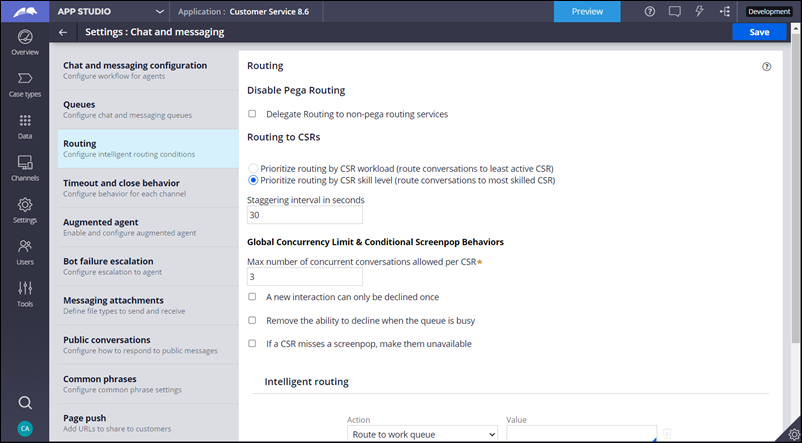
Chat routing
In most cases, a chatbot is the first to receive a request from a customer. When the customer seeks escalation to a human agent (or the chatbot triggers the escalation to a human agent), the Pega routing engine handles the request.
The routing engine assigns the chat request to a customer service representative (CSR) when the CSR:
- Is available for work.
- Possesses the required skill (if enabled).
- Is not assigned another interaction.
- Receives request during work hours for a specific queue.
Access the routing settings in App Studio, by clicking Settings > Chat and messaging, then click Routing.
There are four sections in the settings:
- Disable Pega routing
- Routing to CSRs
- Global Concurrency Limits & Conditional Screenpop Behaviors
- Intelligent routing
Disable Pega Routing
You can use a third-party routing system to route chat requests to a CSR or queue.
For example, if you have a shared pool of CSRs that attend to Pega Call™ and Pega Customer Service™ chat and messaging requests, you can use the Pega Call routing services to route the chat and messaging requests.
When you select the Delegate routing to non-Pega routing services check box, Pega Customer Service redirects the queued chat requests to the configured external service URL as event notifications. Pega Customer Service exposes a REST service over which the external routing system communicates the final routing decision.
Routing to CSRs
You can configure routing to use one of two routing algorithms. When you select an algorithm, the system uses that algorithm for all subsequent routing decisions for chat and messaging interactions.
Prioritize routing by CSR workload
The workload-based option routes new requests to CSRs who have fewer active chats. Choose this option if your objective is to uniformly distribute the incoming customer requests among all available agents. Workload-based routing is applicable when:
- Customer issues are generic and not differentiated.
- CSR compensation is directly tied to the amount of work that they handle, and it is important to distribute work uniformly.
Prioritize routing by CSR skill level
The skill-based routing option routes new requests to the CSR with the highest skill level of all the CSRs that are available to take on more requests. Choose this option if customer interactions are of high complexity and low volume in nature. Skill-based routing is applicable when:
-
Customer issues are complex and non-generic that require differentiated skills in a CSR.
-
Service-level agreements are set and the customer issues require the attention of the most skilled CSR available.
Staggering interval
The value that is entered in this field defines the interval, in seconds, for assigning a conversation to each CSR. For example, if you enter 30 seconds, the routing engine uses a 30-second interval between assigning chat requests to a particular CSR.
Global Concurrency Limits and Conditional Screenpop Behaviors
You can optimize the routing experience by configuring expected CSR responses to new assignment requests.
CSRs handle multiple text-based conversations at the same time (concurrently). The settings in the Global Concurrency Limits & Conditional Screenpop Behaviors section let you define limits globally; the settings apply to all the CSRs that handle text-based interactions.
You can also configure limits at the queue level to specify the maximum number of interactions that a CSR can handle concurrently.
A CSR receives a chat request from a screen pop in the Interaction Portal, as shown in the following image:
To ensure that the wait time estimates that are communicated with the customer are honored, the CSRs must accept chat offers as expected. A level of certainty can be achieved by enabling the settings that are related to screen pop behaviors:
Max number of concurrent conversations allowed per CSR
This option sets the maximum number of conversations that a CSR can accept at one time.
A new interaction can only be declined once
This option prevents the next CSR from declining a conversation assignment request after the first CSR declines it.
Remove the ability to decline when the queue is busy
This option prevents the CSRs from declining the invite when the occupancy level of a queue is red or reaches 80%.
If a CSR misses a screenpop, make them unavailable
This option makes the CSR unavailable in all the queues that they are logged into after an assignment screen pop expires for them. After becoming unavailable, the CSR receives the following notification: You have been made unavailable due to an assignment screen pop expiry.
Intelligent routing
Intelligent routing uses the metadata that is captured for each messaging interaction to route requests to specific queues. The metadata includes the identified language, message type, and channel data .
For example, you can create a routing condition to route public messages to a public queue. In the routing condition shown in the following image, messages from Facebook Messenger (which sends a public message) are routed to a queue named Public. When a CSR handles a message from the Public queue, the CSR knows that anyone can view the replies.
This Topic is available in the following Modules:
If you are having problems with your training, please review the Pega Academy Support FAQs.
Want to help us improve this content?




